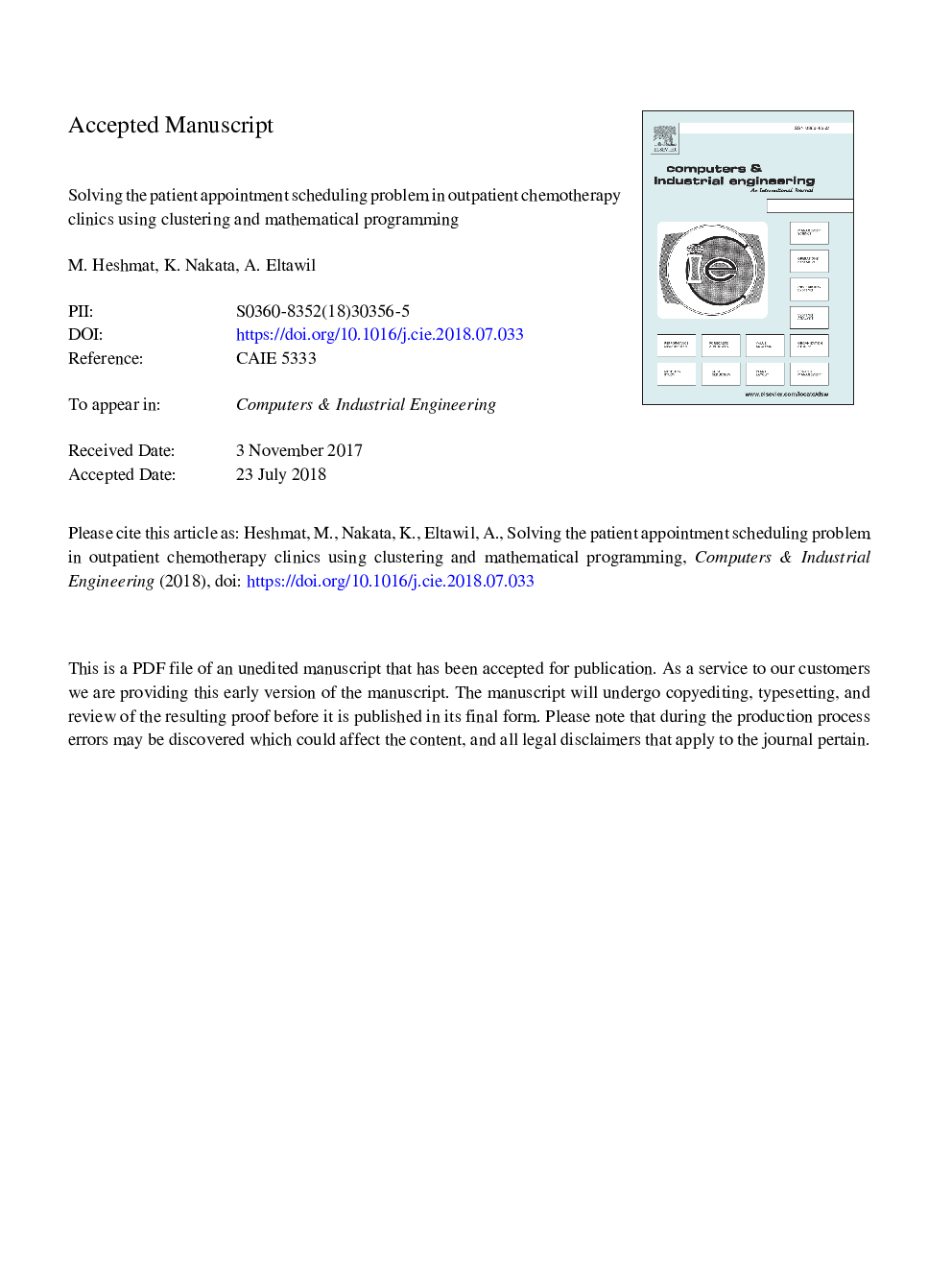| کد مقاله | کد نشریه | سال انتشار | مقاله انگلیسی | نسخه تمام متن |
|---|---|---|---|---|
| 7540698 | 1489042 | 2018 | 40 صفحه PDF | دانلود رایگان |
عنوان انگلیسی مقاله ISI
Solving the patient appointment scheduling problem in outpatient chemotherapy clinics using clustering and mathematical programming
ترجمه فارسی عنوان
حل مسئله برنامه ریزی انتصاب بیمار در کلینیک های سرپایی شیمیدرمانی با استفاده از خوشه بندی و برنامه ریزی ریاضی
دانلود مقاله + سفارش ترجمه
دانلود مقاله ISI انگلیسی
رایگان برای ایرانیان
کلمات کلیدی
یا در خدمات بهداشتی، شیمی درمانی سرپایی خوشه بندی برنامه ریزی قرار ملاقات بیمار،
ترجمه چکیده
مشکل زمان بندی قرار ملاقات بیمار در کلینیک های سرپایی شیمیدرمانی یکی از مهم ترین و چالش برانگیزترین مشکلات به علت تعداد زیادی متغیرهای دودویی و در نتیجه زمان های غیر محاسباتی غیر واقعی است. در این مقاله، ما پیشنهاد یک رویکرد جدید الهام گرفته از ساخت سلول برای کاهش تعداد متغیرهای دودویی و محدودیت. رویکرد پیشنهادی شامل دو مرحله است: مرحله خوشه بندی و مرحله برنامه ریزی ریاضی. در مرحله خوشه بندی، الگوریتم های خوشه بندی فعلی برای یافتن اعضای خوشه مطلوب برای یک ترکیب خاص بیمار مورد استفاده قرار می گیرند. خوشه های به دست آمده در مرحله دوم، یعنی مرحله برنامه ریزی ریاضی، به منظور بهینه سازی هر پرستار به یک خوشه بیمار و یک گروه از صندلی ها در شکاف زمان مطلوب اختصاص می یابد. تابع هدف مدل برنامه ریزی ریاضی، دستیابی به حداقل زمان تکمیل تمام تداخلات است. در مقایسه با مدل های قبلی، رویکرد پیشنهادی از مزایای دادن راه حل بهینه برای مشکلات واقعی در محاسبه زمان بسیار کمتر است. یکی دیگر از مزیت این است که به جای اختصاص یک پرستار فقط برای شروع درمان، پرستار به هر خوشه بیمار در طول دوره درمان اختصاص داده می شود.
موضوعات مرتبط
مهندسی و علوم پایه
سایر رشته های مهندسی
مهندسی صنعتی و تولید
چکیده انگلیسی
The patient appointment scheduling problem in outpatient chemotherapy clinics is one of the most important and challenging problems due to large numbers of binary variables and thus unrealistic computation times. In this paper, we propose a new approach inspired from cellular manufacturing to reduce the number of binary variables and constraints. The proposed approach consists of two stages: the clustering stage and the mathematical programming stage. In the clustering stage, current clustering algorithms are used to find the optimum cluster members for a given patient mix. The resulted clusters are used in the second stage, namely the mathematical programming stage to optimally assign every nurse to a cluster of patients and a group of chairs at the optimum time slot. The objective function of the mathematical programming model is to achieve the minimum total completion time of all treatments. Compared to the previous models, the proposed approach has the advantage of giving the optimum solution for real problems in much fewer computation time. Another advantage is that a nurse is assigned to each cluster of patients along their treatment durations instead of assigning a nurse just to start up the treatment.
ناشر
Database: Elsevier - ScienceDirect (ساینس دایرکت)
Journal: Computers & Industrial Engineering - Volume 124, October 2018, Pages 347-358
Journal: Computers & Industrial Engineering - Volume 124, October 2018, Pages 347-358
نویسندگان
M. Heshmat, K. Nakata, A. Eltawil,
